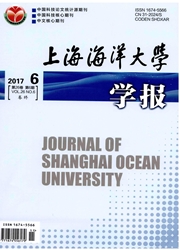

 中文摘要:
中文摘要:
采用群体选育、养殖实验和定期采样的方法,比较了中华绒螯蟹二龄早熟和晚熟选育群体第三代(G3)和非选育群体在扣蟹阶段的生长、成活率、平均体质量、体质量分布比例和产量,结果显示:(1)二龄早熟雌体在7-8月和9-10月的增重率(WGR)及特定增长率(SGR)显著高于二龄晚熟雌体(P〈0.05);无论雌体还是雄体,二龄晚熟群体在7-10月总体生长速度显著低于对照组(P〈0.05),整个实验期间3群体的生长速度大小顺序为:对照组〉早熟G3〉晚熟G3(P〉0.05);(2)二龄早熟和晚熟群体G3在扣蟹阶段的成活率接近,但二龄晚熟群体的成活率显著高于对照组扣蟹;二龄早熟群体G3最终扣蟹平均体质量显著高于晚熟扣蟹,对照组居于两者之间,3组扣蟹产量高低顺序为:早熟G3〉晚熟G3〉对照组;(3)就扣蟹体质量分布而言,3群体扣蟹体质量主要集中于小于3 g和3~6 g这两个体质量范围内,晚熟G3在小于3 g和3~6 g两个体质量范围内比例最高。综上,二龄早熟群体G3在扣蟹阶段具有生长速度快、扣蟹平均体质量大和单产高的优点,二龄晚熟群体G3在扣蟹阶段的成活率显著高于对照组,两选育群体G3在扣蟹养殖上均具有一定的优良性状。
 英文摘要:
英文摘要:
The extension of maturing time of second-year Eriocheir sinensis is one of the important breeding goals, and the early-maturing (EM) and late-maturing (LM) of second-year E. sinensis have been mass selected to the third generation ( G3 ), but their juvenile culture performance is not evaluated to date. Therefore, this study was designed to compare the culture performance of EM, LM and non-selective populations ( as the control) during the juvenile culture stage of E. sinensis based on the methods of selective breeding, culture experiments and regular sampling. The results showed that : ( 1 ) The females of EM had the significantly higher weight gain rate (WGR) and specific growth rate (SGR) than those of LM during the periods of Jul. to Aug. and Sep. to Oct. (P 〈 0.05). Despite of males or females, the WGR of LM was significantly lower than that of control treatment during the period of Jul. to Oct. (P 〈 0.05 ), and the order of WGR for three populations was control 〉 EM 〉 LM throughout the experiment (P 〉 0.05). (2) The similar survival was detected between EM and LM juveniles, however, the significantly higher survival was found in LM than the control treatment; The final mean weight of EM was significantly higher than that of LM juveniles, and the final body weight of control treatment was between EM and LM; In harvest, the juvenile production order of the three populations was EM 〉 LM 〉 control. (3) As for the size distribution of juvenile crabs, the body weight of most juveniles were concentrated on the ranges of 0 - 3 g and 3 - 6 g, and LM had the highest percentages in those two ranges. In conclusion, EM population showed the faster growth than the other two populations, resulting in the greater final average body weight and higher yield during juvenile crab culture stage, and LM had the significantly higher survival than control treatment; therefore, two selective populations of E. sinensis have their good traits during the juvenile culture s
 同期刊论文项目
同期刊论文项目
 同项目期刊论文
同项目期刊论文
 期刊信息
期刊信息
